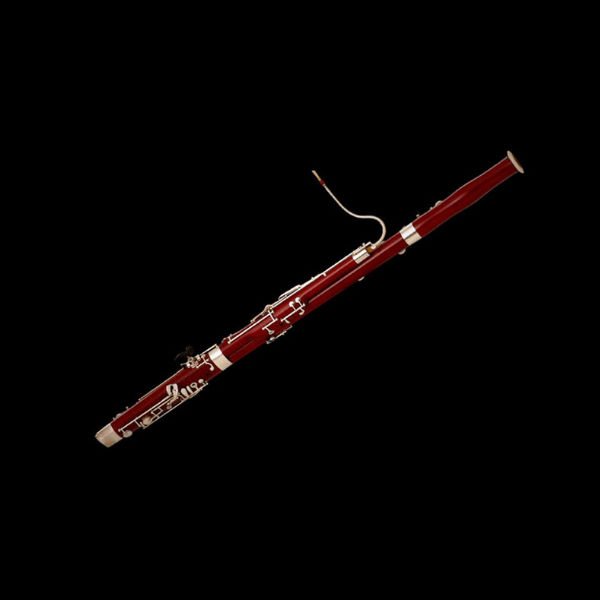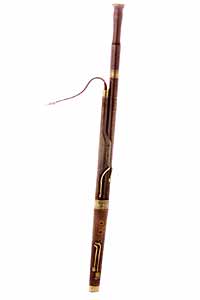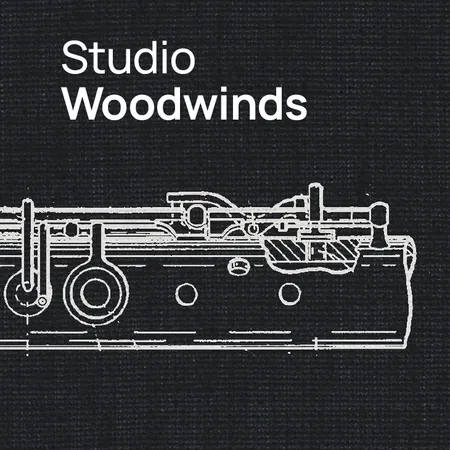
Name: Bassoon
Spelling
German: Fagott
French: basson
Italian: fagotto
Classification: Aerophone, double-reed instrument, woodwind instrument
Material: Maple (wood body), brass, nickel silver (bocal, keys, U-bend)
Mouthpiece: Double reed, 15.5 mm wide: two reeds lying close together (material: arundo donax), striking reed
Tube: Length 250-259 cm, U-shaped, conical
Bore: Very narrow; tapers from 4 mm (wing) to 40 mm (bell)
Keys/fingerholes: 24-27 keys, 5 open fingerholes (Heckel bassoon)
Bell: Cylindrical, finished with an ornamental rim of ivory or plastic
Strap/belt
Height: Approx. 135 cm
The bassoon is a woodwind instrument in the tenor and bass register.
Like the oboe, the bassoon is a double-reed instrument, because the mouthpiece has two reeds that lie very close together. Unlike the oboe the shawm-like sound that this mouthpiece produces is tempered by the U-shaped bend of its wind duct, so that bassoon notes are not a homogeneous continuation of the lowest notes of the oboe's compass.
The bassoon's conical tube consists of the following five components: Crook or bocal: A narrow, curved metal tube connecting the double-reed mouthpiece to the wood body; the bocal has an aperture for the so-called piano mechanism; the bassoon's overall intonation can be altered by the use of bocals of differing length. Wing joint: the bocal joins the straight, wood wing joint or tenor joint, which is shorter and narrower than the long joint that runs parallel to it. Double or butt joint, boot: the boot is a U-shaped hollow piece of tube which is attached to the wing and long joints. The hand rest for the right hand is screwed onto the boot, which ends at the bottom with a metal U-bend. Long joint: This is the longest piece of tubing, and is parallel to the wing joint. Bell: is often finished with an ornamental rim of ivory or plastic. If an A bell is fitted to the customary Bb bell the instrument's range is increased by a half tone downward to A1.
In the 20th century the German Heckel bassoon (that originated with Carl Almenraeder and Johann Adam Heckel) with its 24-27 keys and five open fingerholes became the international standard.
The French Buffet model, the basson, has 22 keys and six open fingerholes. Its tube is narrower, which means the highest notes speak more easily.
Discover our Bassoons
In the Middle Ages shawms - wind instruments played with either a single or a double reed - were common throughout Europe.
The forerunner of modern bassoons and oboes was a kind of shawm which generally had seven sound holes, a conical tube and a double reed. This was the bombarde or pommer.
In the 16th century instrumental polyphony evolved, following the example of vocal music. This development led to the construction of instrument families. During the Renaissance period the bombarde or pommer family included instruments in seven ranges, from the third octave above middle C (treble shawm, the direct antecedent of the oboe) to the contraoctave (great bass shawm). The name was derived from the low instruments, the bomhardes (from the Latin bombus meaning “muffled sound”, “rumble”).
In the course of attempts to extend the range downward it became necessary to produce a bass instrument also for the woodwind family which was on the one hand sufficiently agile and loud and on the other easy to handle. With the great bass shawm, the deepest member of the family, the shawms had reached the limits of their development: aside from the fact that its almost 3 meters long, straight tube was extremely unwieldy, a further downward extension of its range (to below F2) was out of the question due to the fingering problems it posed.
Attempts were therefore made to construct a maneuverable bass instrument by “folding” the tubing after the fashion of the trumpets and trombones to make it shorter. In the second half of the 16th century these attempts resulted in the construction of an instrument the body of which consisted essentially of a hollowed-out, U-shaped wooden block. The tubing was conical along its entire length. A small S-shaped tube was attached to the narrow end of the tube to which the double reed was fixed. The other end flared out to form a bell.
Because this new instrument possessed a mellow and pleasant sound which distinguished it from the pommers it was given the name dulcian (“sweet-sounder”). It is not known in which workshops dulcians, the direct antecedents of the modern bassoon, were first made.
For many years the so-called phagotum was regarded as the direct forerunner of the modern bassoon. This was an instrument with two parallel wooden pipes which was made from 1513 onward by the Italian collector of musical instruments Afranio degli Albonesi. However, it was later found out that it really belonged to the bagpipe family, since it had metal reeds which were vibrated by means of bellows.
Beside the name dulcian the appellations fagot, curtall and basson were also adopted very early in the instrument's history and were used at the same time.
The French term fagot meant “bundle of sticks, faggot”, and was first applied to a musical instrument in Italy in the early 16th century. Since the middle of the 18th century the bassoon has been known as the Fagott in German-speaking countries and the fagotto in Italian. The name curtall (German: Kortholt) literally means “short wood” and was the earliest name given to the dulcian in England. The term was adopted after the instrument had been curved into a U shape and thus considerably shortened, and is derived from the Latin word curtus meaning “short”. The French term basson originally had the general meaning of “bass”.
Dulcians were made in several tunings. In the second volume of his Syntagma musicum (1620) Praetorius includes a total of eight tunings.
The choristfagott enjoyed special status among the dulcians from the very beginning. It was first mentioned in 1592 in Zacconi's Prattica di musica and was about one meter tall, had eight finger-holes and two keys. Its range was from C2 to G4, with the notes from C3 upward being produced by overblowing. The bell often had a perforated lid which made it sound similar to a stopped organ pipe.
The appellation “choristfagott” possibly derived from the fact that the instrument was used to reinforce the bass voice of the choir. It played a leading role in sacred music of the 17th century and subsequently also in opera and concertante music, in which it was increasingly able to liberate itself from its restrictive role as a support to the bass and appear in consort with other dulcians, in small ensembles and even as a solo instrument, for instance in Selma y Salaverde's Canzoni, fantasie et correnti, 1638). Its debut as an orchestral instrument was probably in 1668 in Antonio Cesti's opera Il pomo d'oro .
Challenging techniques were being required of stringed instruments as early as the 17th century, and the strings were proving themselves more than capable of meeting them. Greater demands were subsequently made on the wind instruments, too, particularly with regard to range and sound quality. These new demands meant that the pommer, with its inflexible timbre and limited range, gradually disappeared. The dulcian, on the other hand, possessed a host of qualities which made it ideally suited for further development.
In the middle of the 17th century instrument makers in Amsterdam, Paris and Nuremberg began constructing the body of the choristfagott in four parts: wing joint, boot, long joint and bell. The range of the new, four-part instrument, which became generally known as the bassoon (French: basson) was extended downward by a whole tone. This meant that the bassoon, which now had three keys (F2, D2 and Bb1), was able to hold its own against the contemporary bass instrument of the string family, the basse de violon. What it did not have, however, was the notes B1 and C#2.

Bassoon, Munich, Stiegler (Germany), between 1770 and 1815, 8-key system. Courtesy of Alois Fischer, Windischgarsten (Musikinstrumentenmuseum Schloss Kremsegg, Austria, Collection Streitwieser)
The new bassoon fulfilled a number of different functions: together with two oboes it formed a woodwind group that was used to contrast with the strings (by Jean Baptiste Lully or Henry Purcell, for example). In orchestral composition it was given the task of playing obligatos (by J.S. Bach, for instance), and many composers, such as Antonio Vivaldi, wrote bassoon concertos. In chamber music it was often used in sonatas and trio sonatas (e.g., by G.F. Handel and Jan Dismas Zelenka [1679-1745]). In the Classical period numerous chamber music pieces for bassoon and strings were written. In the orchestra, two bassoons were used.
In the 18th century improvements to the bassoon focused primarily on increasing the number of keys.
In around 1700 the bassoon was given a fourth key (the G# key for the right little finger). This determined the playing position of the hands (right hand below the left) once and for all. Further additional keys were to improve the quality of some of the low notes, which had previously been played using cross-fingerings. The addition of speaker keys - for which reliable evidence exists from 1787 - represented a major step forward, since they made overblowing considerably easier. The most famous classical workshops were Bizey, Lot and Prudent in France and Grundmann and Grenser in Germany.
Although it was possible to play notes in the high register up to F5 on bassoons with five keys, it was not until the speaker keys were added that contemporary composers were persuaded to ask for notes above G4. In about 1810 models with six keys and two additional speaker keys on the wing joint (for A4 and C5) became standard.
Compared to the other woodwind instruments, the number of significant changes made to bassoon construction in the course of the 18th century was small. This “neglect” became particularly apparent at the beginning of the 19th century, as the bassoon began to have obvious difficulties coping with the growing demands made with respect to sound quality and technique in orchestra and solo literature: The notes B1 and C#2 were still missing from the range, the tone quality of a number of other notes was very poor and legato playing proved extremely difficult especially in keys containing a large number of accidentals.
This situation changed dramatically in the 19th century thanks to the innovations of several instrument makers, and most especially thanks to Carl Almenraeder's (1786-1843) sweeping reforms.
Leading workshops in Paris, Vienna and Dresden made valuable contributions to solving the tuning problem by equipping their instruments with tuning slides on the wing joint or providing wings or bocals of various lengths. Keys for B1 and C#2 were added. To increase the volume attempts were also made to widen the bell. The boot was given the short, U-shaped joint in place of the cork component.
In 1817 the bassoonist and instrument maker Carl Almenraeder from Mainz in Germany embarked on a project which was to last years and ultimately result in a technically complete, agile and responsive bassoon with a well-balanced overall sound.
Beside his own mechanical improvements Almenraeder also made use of the inventions of other instrument makers and adopted some of the suggestions of his friend Gottfried Weber, who had undertaken a thorough study of the acoustic properties of woodwind instruments. He placed the tone holes from A2 downward nearer the bell and increased their diameter. He also replaced the resonator hole in the bell with an open key for B1.
In 1843 Almenraeder's comprehensive guide to his 17-key bassoon was published. This instrument had a chromatic range from B1-Bb5, in other words, four octaves. Following his death his colleague Johann Adam Heckel (1812-1877) took over the management of the workshops they had started together in 1831.
Today, following several further alterations, the German Almenraeder-Heckel bassoon has 25-27 keys. It first gained popularity in the German-speaking world and became the international standard during the 20th century.
In France, the Romance countries and parts of Canada, on the other hand, a French model with 22 keys is in use.
The basson has tubing which is longer and more narrowly conical; the tone holes are narrower. Unlike the German bassoon the French basson has a closed Bb1 key, the tone holes for B1, C#2 and D#2 are drilled in the front side and the tone hole for E2 (on the boot) has no key. It developed in the workshops of J. F. Simiot de Lyon, Frederic Guillaume Adler (died 1857), Savary (1786-1859), Jean Nicolas (1786-1853), Frederic Triébert (1813-1878) among others and was later further refined by the firm of Buffet-Crampton.
Although the fundamental scale is in F, the bassoon is a non-transposing instrument (actual pitches are notated).
Notation is in bass clef, with tenor clef being used for the higher registers. Notation in treble clef is rare.
The bassoon has a range from Bb1 - Eb5 (F5).
- Bb1 - F2
- F#2 - Bb3
- B3 - Eb5 (F5)
The original Almenraeder bassoon could go as high as Ab5. On modern instruments E5 and F5 cannot be played without considerable effort. Experienced players can play even higher pitches, which are no longer asked for in the orchestra.
The double reed is placed between the lips and blown, which sets the two reeds vibrating against each other. They open and close very quickly, thereby sending little puffs of air into the air column inside the instrument, which is stimulated to move in sympathy.
As on all woodwinds it is primarily the keywork that is used to produce the various pitches. The technique of overblowing - the bassoon overblows to the octave - is largely replaced by the use of speaker keys. Five of the tone holes are closed directly by the fingers, the rest by keys.
By attaching a so-called A bell, which is fixed to the customary Bb bell, A1 is playable too.
The notes from F#3 to D4 are produced by overblowing the fundamental scale (first-degree overblowing), the fingering is the same as that for the lower octave.
For the notes Eb4 to Eb5 (and above) special fingerings or combinations are used.
Note
- keys with very long levers;
- the tube walls of the bassoon are exceptionally thick, which makes it possible to place the fingerholes at an angle to the wood. Bassoonists can therefore reach all five fingerholes with no difficulty. The thickness of the walls is also an important factor in determining the instrument's timbre.
Due to its U shape, condensation from exhaled air or saliva collects in the instrument. To prevent decay the boot and the tone holes on the wing joint are lined with rubber or a similar material.
To play, the bassoon is held diagonally across the body with the left hand at the top and the right hand at the bottom. The left hand covers the five fingerholes and sixteen or so keys on the wing joint and long joint, the right hand the approximately eleven keys on the boot.
The size and weight of the bassoon means that it must be supported while it is being played. Bassoonists hold the instrument with the aid of a strap which goes round the neck or shoulders and is hooked into a ring on the instrument's boot. For playing in the sitting position the belt is used as an alternative - the musician sits on a leather strap with a pouch at the end which holds the U-bend.
For an instrument of its size the bassoon is amazingly agile. Rapid passages - except with the very lowest notes - are possible as are large leaps.
For an instrument of its size the bassoon is amazingly agile. Rapid passages - except with the very lowest notes - are possible as are large leaps.
Microtonal periodic fluctuations in pitch and/or volume which are produced by movements of the diaphragm, larynx and lips.
The use of vibrato on the bassoon has now become widely accepted.
Sforzando
Forced, short attack followed by a rapid reduction in tone intensity.
Sforzandissimo
Forced, short attack with continuance of tone intensity.
Fortepiano
Rapid dynamic reduction from forte to piano.
Asked for in more modern literature. Double and triple tonguing are hard to perform on the bassoon because the articulation is hindered by the reeds in the mouth. From tempo MM 150.
Young musicians often play passages like those shown in the example with double-tonguing, whereas bassoonists of the old school play them with single-tonguing.
A rolled (guttural) R against the palate is generally used, since the lingual R (produced with the tip of the tongue) is made more difficult by the reed and hampers the embouchure. The slower the articulation, the softer the sound. This technique can be performed over the entire range but is harder to play piano and in the upper register.
Trills are not among the bassoon's typical playing techniques and cannot be performed to the same extent as on the flute, oboe and clarinet.
Whole tone trills are playable from Bb1 to around A3. Trills on low notes are harder to play, especially the whole tone trill above C#2.
Half tone trills are possible from C2-C4.
Like trills, tremolo is not one of the playing techniques typical of the bassoon. They are used mostly in tutti passages, where they are more or less veiled by the rest of the orchestra. They should not go over more than a major third (in exceptional cases a fifth). Tremolos between C3 and G4 are easiest to perform.
The larger the interval, the slower the speed at which the tremolo can be performed.
The finger glissando is produced by partly covering the tone holes or by changes of fingering. Glissandos are particularly easy to play between A2 and F3, because it is in this area that the open fingerholes are found. Rapid glissandos are only possible over smaller intervals and are generally harder to play at the top or bottom end of a register and in the lower register.
In principle lip glissando can be played at every pitch. Depending on the initial note the pitch can be altered by up to a half tone upward and a whole tone downward.
Mutes give the bassoon a more mellow sound.
Pieces of cloth are often placed in the bell as a mute (required by György Ligeti, for example). Less frequently, commercially manufactured perforated cloth mutes or cork mutes are used.
Describes a modern fingering and blowing technique which makes it possible to play two or more notes at the same time. Playing more than three notes simultaneously is difficult.
The bassoon is blown in such a way that a partial (or several partials) of the fingered note speaks as well, or that only the partials sound. Multiphonics are produced by using special fingerings and changing the force of attack on the reeds at the same time or by using conventional fingerings with a radically altered embouchure.
In the low register great lip or embouchure pressure produces major chords; in the upper register a multitude of triads are possible by reducing lip or embouchure pressure. The special fingerings in the upper register usually result in multiphonics outside the series of harmonic partials. Fingering charts for multiphonics can produce different results on different types of bassoon and must therefore be tried out.
20th century composers include incidental noises that arise from playing as part of their compositions. For example, they call for the noises made by the bassoon's keys themselves.
A distinction is made between purely percussive effects - which are louder if the instrument or its keys are bigger - and resonance effects, which have a more or less discernible pitch. Below the fingered note the key or keys are indicated which are to be slapped.
The bocal (with no reed) is briefly blown then abruptly stopped by the tongue. This produces a full resonance especially in the scale from B1 to F3.
Rolling sound, slurping noises, blowing through, sucking noises, vocalizing while playing, playing only the tube, playing without the tube, playing with a trumpet embouchure, circular breathing, use of electronic devices …
Mellow, gentle, velvety, mild, sonorous, warm, smooth, picturesque, tense, active, penetrating, plaintive, long, light, delicate, full, round, slender, narrow, sensitive.
The U-shaped bend of the bassoon tube means that it lacks the penetrating and brilliant shawm-like sound of the oboe.
The bassoon's timbre is rich in harmonics, which gives it particular color. The differences between the registers are very pronounced, which is one of the instrument's most striking characteristics: full and sonorous in the lower register, slender, elegant and melodious in the middle and narrow and compressed in the upper register.
In all its registers, the notes of the bassoon - especially staccato notes - are well suited for the performance of humorous, comic effects and the depiction of musical caricatures.
Low registerBb1 - F2
The bassoon's low notes with their substantial, compact and unobtrusive sound are often used as a bass foundation. They sound somewhat thicker and heavier than the higher notes and evoke a marked sense of serenity, peace and equanimity in pp passages.
In addition to this, composers have given them thematic tasks with a solemn, proud, dignified and majestic character.
Middle registerF#2 - Bb3
The notes in this register are those used most often on the bassoon, being ideally suited not only for tonal blends but also for solo work. The notes sound sonorous, rich, clear and stately. They are more intense than the low register and possess a wide range of expression; they can be gently caressing or sharply austere, merry and bright or melancholy and despondent. They are equally well suited for mysterious, demonic and eerie effects.
Upper registerB3 - Eb5
Because the high notes of the bassoon contain considerably fewer overtones than the low notes they do not possess the same clarity and are often felt to sound “squeezed” or “pressed” (though not shrill). This perception is reflected in countless passages in the literature in which the bassoons express apprehension, lamentation, distress, hardship, agony and fear.
The high notes also have a lyrical character, however, and can perform cantabile tasks.
The fascination of the bassoon's sound lies in two qualities:
On the one hand, it achieves a good blend with most of the other instruments in the orchestra, as does the horn; This capability to blend with the sound of other instruments allows the bassoon to merge with the overall sound of the orchestra as an unobtrusive bass voice.
On the other hand, the bassoon's sound is also clearly defined and therefore suitable for thematic and solo tasks.
Produce a homogeneous, full-sounding and sonorous overall sound. In the orchestra of the Classical era it had become customary to use two bassoons which functioned purely as bass instruments. The bassoon retained this function in later styles, too, although it was increasingly entrusted with melodic tasks as well. Since the Romantic era a contrabassoon has been added to reinforce the sound an octave deeper and thus compensate for the increased volume of the larger orchestra.
Produce an interesting combination. The flute often plays one or two octaves above the bassoon, but the two instruments can also play in unison in the flute's low register.
In the woodwind group the oboe often plays an octave above the bassoon. Although the resulting sound is powerful and the instruments are related due to the double reed, no tonal blend is achieved. The bassoon is dominated by the more incisive and reedy sound of the oboe. The combination with the deep oboes, on the other hand - the English horn and the Heckelphone - is very homogeneous.
When the bassoon plays in unison with the high woodwinds in their low registers, the sound is always dominated by the latter. With the clarinet playing an octave higher a mellow, substantial sound results. The mellow sound of the bass clarinet supports the bassoon in bass tasks in unison, in chords or an octave lower.
The bassoon and the horn, which both possess an extremely mellow and full sound as solo instruments, produce an impressive volume when played in unison, which is particularly effective in tutti passages. The two instruments also produce a homogeneous blend in chords.
The bassoon takes the edge off the trombone's metallic timbre, making it more mellow, but is dominated by the trombones. The combination with trombones an octave above and tubas in unison or an octave below produces a mighty bass voice which is used especially to provide a solid bass foundation in passages scored for many instruments.
In combination with the strings exceptionally velvety and voluminous blends are produced in which either the bassoon (or other woodwinds) or the strings can dominate, depending on the dynamic levels. The bassoon's staccato combines very well the strings' pizzicato.
Combine to produce a powerful, mellow and sonorous overall sound in unison. Supported by the double-bass an octave below this is the standard combination for bass tasks.
Full-sounding bass blend either in unison or with the bassoon an octave above. Staccato notes reinforce the double-bass's pizzicato, legato notes “prolong” the pizzicato's sustain.
Reinhard Keiser
- Atalanta (1698), Octavia (1705)
George Frideric Handel
- Oratorios
Johann Sebastian Bach
- Cantatas (obligato parts), Sinfonia F major
Carl Philipp Emanuel Bach
- Die Israeliten in der Wüste (oratorio, 1769)
Joseph Haydn
- Late symphonies (2 bassoons)
Wolfgang Amadeus Mozart
- Jupiter symphony
Ludwig van Beethoven
- 4th symphony
Hector Berlioz
- La Damnation de Faust
Giuseppe Verdi
- Don Carlo, Otello, Messa da Requiem
Richard Wagner
- Der Ring des Nibelungen (4 bassoons)
Pjotr Ilyich Tchaikovsky
- 4th, 5th, 6th symphonies (solo bassoon in 6th)
Gustav Mahler
- Symphonies (4 bassoons, contrabassoon)
Nicolai Rimsky-Korsakov
- Schéhérazade op. 35 (1888)
Igor Stravinsky
- Le sacre du printemps (1913)
Maurice Ravel
- Boléro
Dmitri Shostakovich
- 9th symphony
Antonio Vivaldi
- 39 bassoon concertos
Johann Baptist Vanhal
- Concerto F major for 2 bassoons and orchestra
Wolfgang Amadeus Mozart
- Bassoon concerto in B-flat major, K. 191/186e (1774)
- Sinfonia concertante in E-flat major (for oboe, clarinet, horn, and bassoon)
Joseph Haydn
- Sinfonia concertante in B-flat minor(for oboe, bassoon, violin, and cello)
Carl Maria von Weber
- Bassoon concerto in F major, op. 75 (1811)
- Andante e Rondo ungarese op. 35 (1816)
Richard Strauss
- Concertino for bassoon and clarinet, op. 147 (1947)
Paul Hindemith
- Double concerto for trumpet and bassoon
André Jolivet
- Concerto for bassoon, strings, piano, and harp (1954)
Bruno Bartolozzi
- Conzertazioni for bassoon, strings, and percussion (1963)
Sofia Gubaidulina
- Bassoon concerto
Michel Corette
- Le Phénix (4 bassoons and organ or cembalo)
Johann E. Gaillard
- Chamber music for 24 bassoons and 4 double-basses (c. 1745)
Wolfgang Amadeus Mozart
- Sonata B-flat major for bassoon and cello, K. 292
Ludwig van Beethoven
- 3 duets for bassoon and clarinet
- Sextet in E-flat major for 2 clarinets, horns, and bassoons, op. 71 (1796)
Niccolò Paganini
- Piece for violin and bassoon
Francois Devienne
- 3 quartets op. 73 for bassoon and string trio, 1800
Camille Saint-Saëns
- Sonata
Mihail I. Glinka
- Trio Pathétique in d minor for bassoon, clarinet, and piano (1827)
Sergei Prokofiev
- Scherzo humoristique op. 12 for 4 bassoons (1938)
Paul Hindemith
- Kleine Kammermusik op. 24 for flute, oboe, clarinet, horn and bassoon (1922)
Jean Françaix
- 7 impromptus for flute and bassoon (1977)
- Divertissement for bassoon and string quintet (1979)
Karlheinz Stockhausen
- Adieu for woodwind quartet
Georg Philipp Telemann
- Sonata in f minor (1728), sonata in e minor
Johann Friedrich Fasch
- Sonata in C major
Camille Saint-Saëns
- Sonata in G major, op. 168 (1921)
Paul Hindemith
- Sonata (1938)
Henri Dutilleux
- Sarabande et Cortège (1942)
Nikos Skalkottas
- Sonata Conertante op. 67 (1943)
Iván Erőd
- Sonata Milanese (1984)
Egon Wellesz
- Suite op. 77 (1957)
Gordon Jacob
- Partita (1971)
Wilson Osborne
- Rhapsody (1958)
Werner Pirchner
- Mit Fa-Gottes Hilfe (1989)
On this page
- History
- Shawms in the Renaissance period
- The dulcian
- The early bassoon
- 19th century - the birth of the modern bassoon
- Notation
- Range
- Sound production
- Embouchure
- Fingering
- Playing position
- Playing Techniques
- General
- Single Tonguing
- Vibrato
- Sforzato
- Double/triple tonguing
- Flutter tonguing
- Trills
- Tremolo
- Glissando
- Mute
- Legato
- Runs
- Multiphonics
- Key slap
- Slap tongue
- Further modern techniques
- Sound characteristics
- Sound Combinations
- Bassoon and woodwinds
- Bassoon and brass instruments
- Bassoon and strings
- Repertoire (selection)
- Orchestral bassoon
- Concertos for bassoon and orchestra
- Chamber music
- Bassoon and piano
- Bassoon solo



